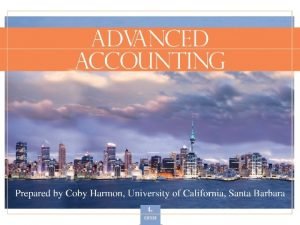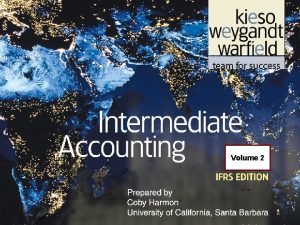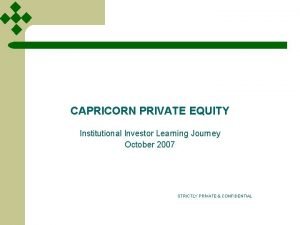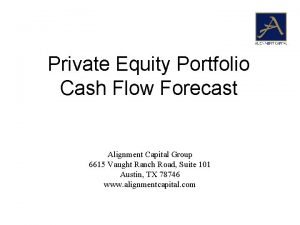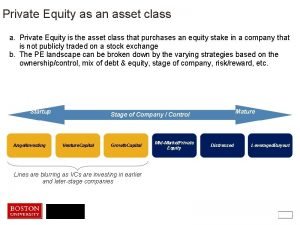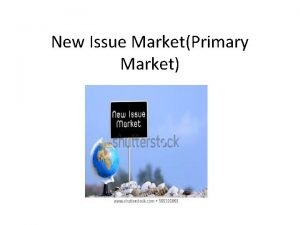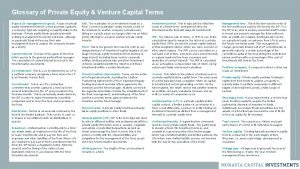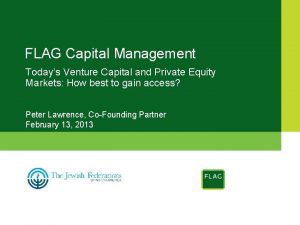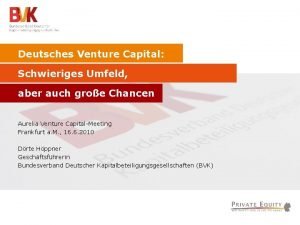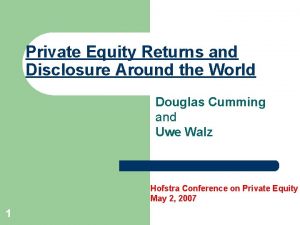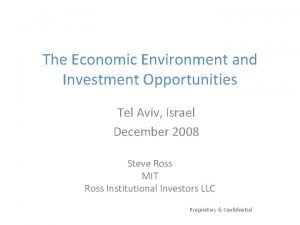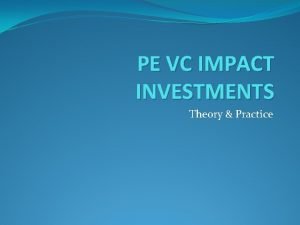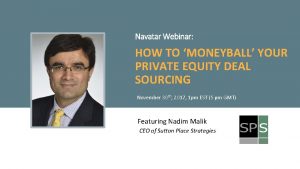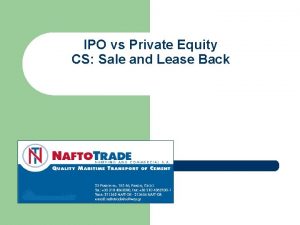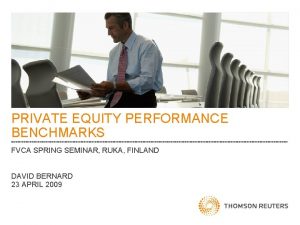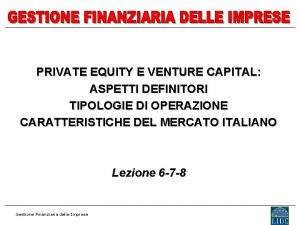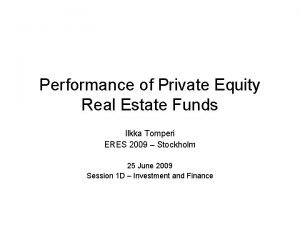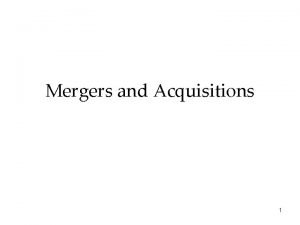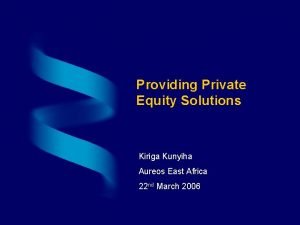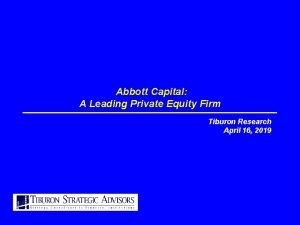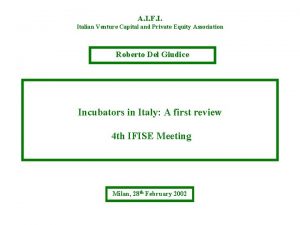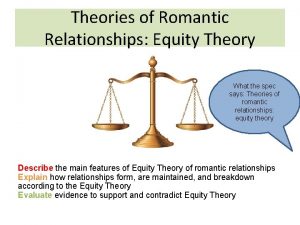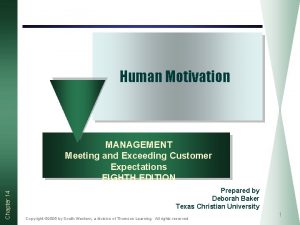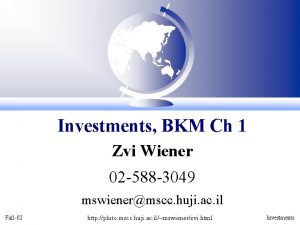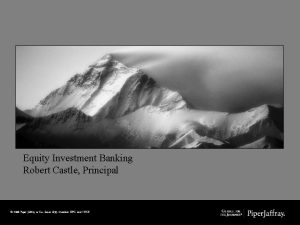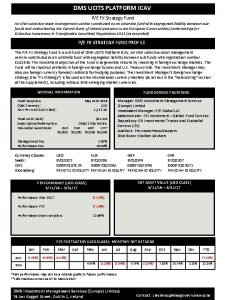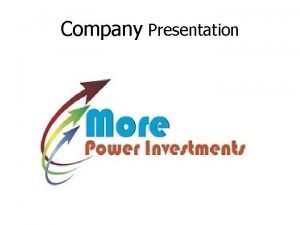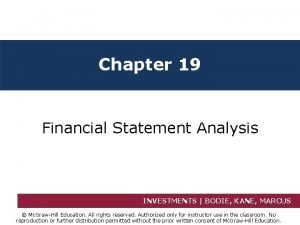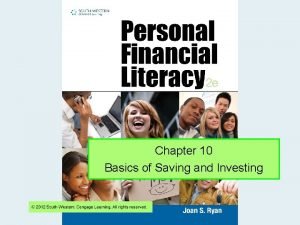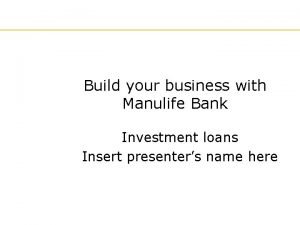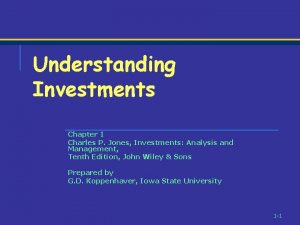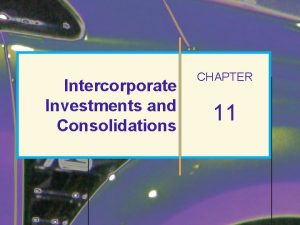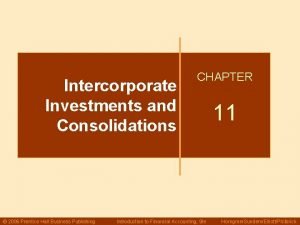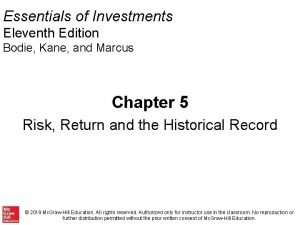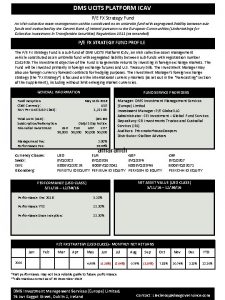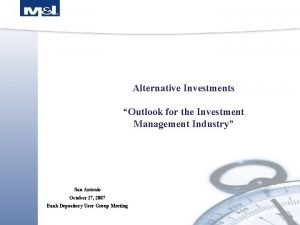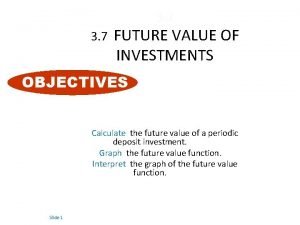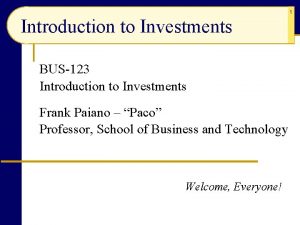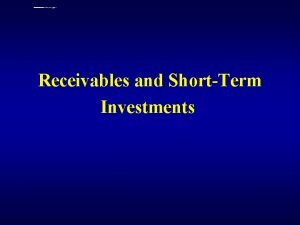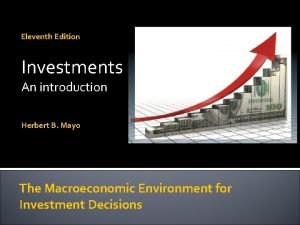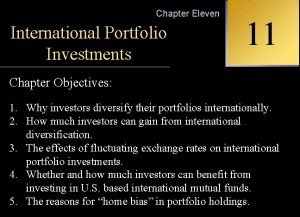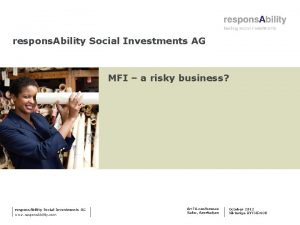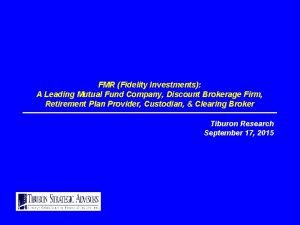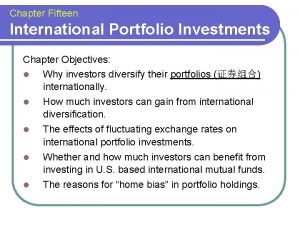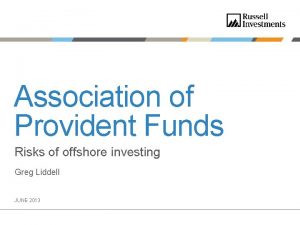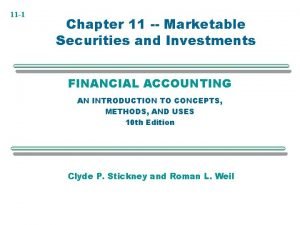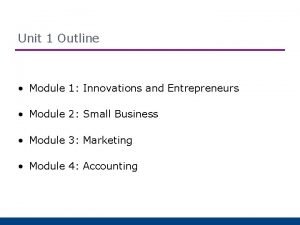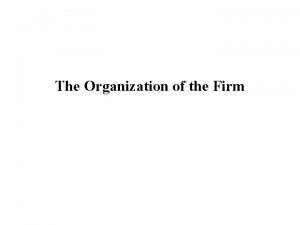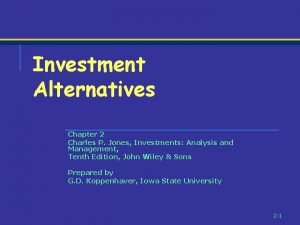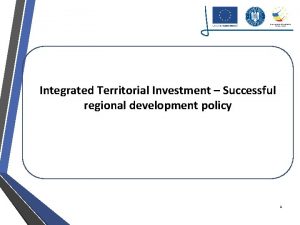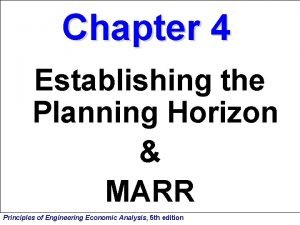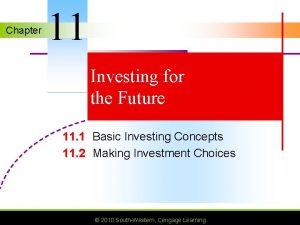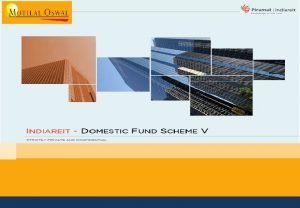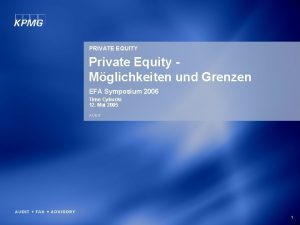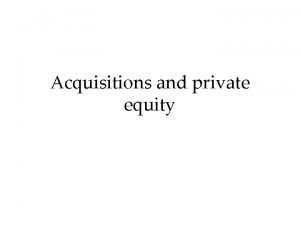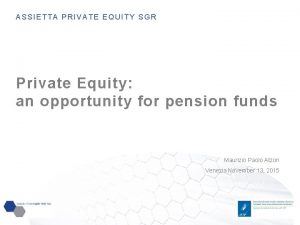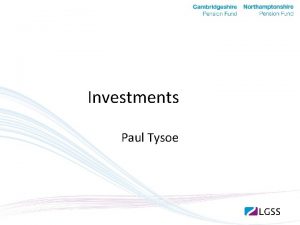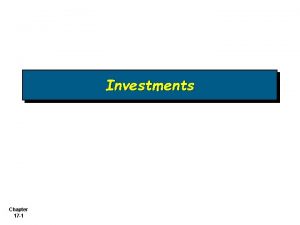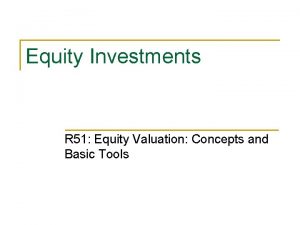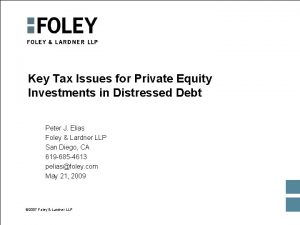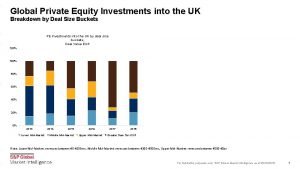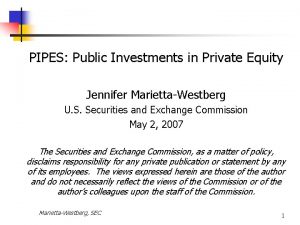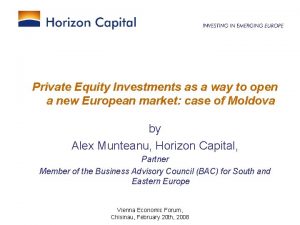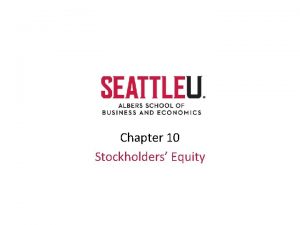PE VC IMPACT INVESTMENTS Theory Practice Private equity





























































































- Slides: 93

PE VC IMPACT INVESTMENTS Theory & Practice

Private equity

Basics �What is Private Equity? �Capital noted on a public exchange �Risk capital brought in by funds / Investors �Investing in equity which may be listed or unlisted �Definition �It is Equity, representing ownership in an entity that is not listed. �Since private equity is often used to gain significant control over firms, it derives capital from very high networth investors and institutional investors.

Structure of a PE Company General Partners Fund Managers Limited Partners Manage Invest Carried Interest Private Equity (Limited Partnership) Investee Companies Invest

Where do they invest? �They have a large scope of investments. �Start ups �Large companies �Distressed assets / companies �Projects (preferably ring fenced) � Usually Longer term � Usually to control Working on buy side

Where does a private equity firm raise funds? �High Networth Individuals �Pension Funds �Banks �Financial Institutions �Institutional Investors �Why do they invest? �To beat the normal public market returns through �Deployment of capital �Bringing in expertise in management

Raising Funds… �Committed Capital �Is the total amount that the LP agrees to invest in a fund over a period of time. �Depending on size of the fund, most funds have a minimum and a maximum amount a limited partner can or may invest. �Committed capital is a legally binding commitment made during the fund raising process �This money is not paid on day one but is drawn over a period of time as and when the fund makes investments. �Different LP’s may commit different amounts; not every LP will invest the same amount. �This amount can not be changed once the fund has been launched. (then next series)

Raising Funds… �Invested Capital �As opposed to committed capital, this money is the actual amount invested by a LP in a fund. �Committed capital is called for, on a pro rata basis. To make investments, and manage day to day expenses. �It is an usual practice to give 14 day notice to LP’s by fund managers / GP’s for such investments. �Capital Call �When a fund manager calls for the committed money this is called draw down or capital call. �Usually periodic e. g. quarterly

Road Shows Collecting Funds – Creating a Brand – Reaching out to Investors

Road Shows � What is a Road Show? � A road show is a presentation by an issuer of securities to potential buyers. The management of a company keen to raise funds travels around to give presentations to analysts, fund managers and potential investors. � The road show is intended to generate show provides an introduction of the offering to potential investors, and was considered a key nonfinancial factor in buying decisions made by 82% of institutional investors in regards to IPOs in a 2014 study by EY. � Usually road shows move across locations; are scheduled in advance & completed over a specific time period excitement and interest and to gauge � The Event � Presentations are made to potential / investor interest. existing investors. � It often critical to the success of the � Corporate information is distributed. offering. � Business plans and forecast is � Road shows may be limited to one showcased and discussed. country or may include international stops � Investor Concerns are addressed � A non deal road show occurs when � Underwriters use these event for book executives hold discussions with building process current and potential investors but � Used to develop a network https: // developer. ibm. com/startups/2016/03/15/to-raise-capital-you-need-a-startup-roadshow / nothing is offered for sale. A road

Road Shows; for large companies or starts up’s also? � For large IPO’s the CEO along with an investment banker(s) go on a global road show to pitch their businesses to potential investors, including: hedge funds, major investment funds, and other portfolio managers. The purpose is simple: drum up sales of the forthcoming stock issue. � In the startup world, there are no big investment banks scheduling meetings. However, there are opportunities to do a road show for your startup, which is even more important than the IPO. � The usual feeling is that road shows are useful for large companies and to raise large sums of money. � There were 275 IPOs in 2014, the largest number since 2000. By contrast, there around 500, 000 new businesses founded in the U. S. each year (not all of which are tech startups), approximately 225, 000 angel investors in the U. S. , and as of a year ago, there were 874 venture capital firms. � In big finance, a few companies compete for the attention of a small, accessible group of investors. � In the startup world, a large number of companies must seek capital from a huge pool of oftenhard-to-find, geographically dispersed investors. Because of this, a road show is even more important for startups than it is for IPOs. Ref IBM global entrepreneur

Investee Companies �Where do PE’s invest? �Venture Cap �Other Funds, (fund of fund) �LBO �Turnaround �Projects �Real Estate �Equity �Start ups

The Secret Where do they really ‘INVEST’?

Buy To Sell � Private equity companies are necessarily in the business of investing for superior returns…within a pre decided time frame. � As opposed to this; Public companies- when they acquire businesses with an intention of synergy and holding on to them are bound to hold businesses or divisions bought. � So clearly buying to sell can not be a strategy (for public companies) since It doesn’t make sense when an acquired business will benefit from important synergies with the buyer’s existing portfolio of businesses. It certainly isn’t the way for a company to profit from an acquisition whose main appeal is its prospects for long-term organic growth. � However, as private equity firms have shown, the strategy is ideally suited when, in order to realize a onetime, short- to medium-term value-creation opportunity, buyers must take outright ownership and control. � Such an opportunity most often arises when a business hasn’t been aggressively managed and so is underperforming. It can also be found with businesses that are undervalued because their potential isn’t readily apparent. In those cases, once the changes necessary to achieve the uplift in value have been made—usually over a period of two to six years—it makes sense for the owner to sell the business and move on to new opportunities. � In fact, private equity firms are obligated to eventually dispose of the businesses

The Secret … �In early years such a buy to sell strategy was fairly simple. Since PE’s targeted underutilized / non core businesses of large companies �More recently PE’s have shifted their focus �To acquiring whole companies �Acquiring new companies and taking them public �Funding probable Unicorns. �Buying divisions with improvement opportunities � Requires strategic skills sets of running core businesses and not only funding capabilities.

Pitch Book

Pitch book – Teaser document � Pitchbook � A pitchbook is a document created by an investment bank or a firm that details the main attributes of the firm/ product / project, and it is used to help sell products and services and generate new clients or investors. � Pitchbook is a helpful guide to the presenter to showcase important features / benefits and to provide visual aids when presenting to clients. � It is used as a sales tool to generate primary information without divulging too much information. Just enough to generate interest is the key. � The task of the investment memorandum is to provide an investor with an opportunity to evaluate the prospects of your project and to make a decision on the investment of funds in your business. � Teaser � Usually precedes the pitch book. � Document used to introduce an idea / acquisition opportunity / Investment opportunity to strategic or financial investors. � Usually does not mention name of company or other details. Called a blind teaser. � The task of the teaser is to draw attention to your business and ensure that your project is shortlisted amongst those of interest to the project investor.

Contents … � Contents Teaser: � brief information about the project (summary): the essence of the project, key characteristics of � � the business and the market; sales channels, structure of the revenues from goods/services; indicators of financial statements, optimally — for the last 3 years; factors of investment attractiveness — your business’ strengths in brief (leadership in a particular market segment, technological or managerial know-how, patents); team: brief information about the project leaders and main personnel. � Contents Pitchbook: � investment attractiveness factors — your business’ strengths (more detailed than in the teaser); � detailed description of the business: the company’s history, ownership structure, production � � � activity, achievements (for instance, research and development), purpose and area of application of the company’s goods/services; market review: overall situation within the particular market segment, analysis of competitors and their share, analysis of consumers of the goods/services; team: leaders and business management structure, information about managers and employees; company’s strategy and financial results, assessment of the financial condition, financial forecast; risks: analysis of key factors that may have an adverse impact on the company’s activity, sensitivity and resistance to changes made to them; offer for an investor — proposed sum and terms of investment, transaction parameters, forecast of the pay back period and the long term objectives of the business.

How does a Private Equity make money?

How does a PE make money? �Usually PE companies charge a management fee to investors for managing their money. �This is usually 2% per annum �On the total assets under management �They also make money on returns generated by investing this capital. �This is usually 20% of gross profits above the hurdle rate �This is called ‘Carried Interest’ This is called the 2 – 20 rule!

�Investors expect a minimum return What is a HURDLE rate? when they invest in a private equity firm �This minimum expected rate of return has to be slightly above the bank rate because the bank interest is practically free of risk but there is an element of risk whilst investing in a PE firm. �Lets assume the bank rate is 8 % � In this case the hurdle rate would be around 12 to 14 %.

More on Carried Interest �Carried interest refers to the private equity firm’s share of the capital gains generated by a fund, which are created by earning profits on portfolio investments. �Firms typically realize returns on their investments by selling the company or taking it public, but another option is a dividend recapitalization.

How does a PE make money? (2) �Management Fee �If the AUM of a fund is 100 crores. �And the management fee is 2% �The Annual management fee would be Rs. 2 crores. �This would be used for salaries, rent, travel, office expenses etc.

Example of Carried Interest �Is a percent of profit earned �Above the hurdle rate of return �Profit is calculated as a whole and not on a deal to deal basis. �Example: (very simple example ) � AUM 10 Million USD � Company bought for 10 million USD � Sold for 15 Million USD � Profit is 5 Million USD � Hurdle rate is 10% � Profit after hurdle rate is 4 Million USD � Carried interest is 20% � Hence fund managers will earn 800, 000 USD (20% of $ 4 M) as carried Interest.

Calculating Net Profits and Carry Distribution � Private equity firms may have their own formula for distributing carry across the firm’s managing partners, senior managers, and staff. � Carry distribution may depend on title, experience, expertise and contribution to fund performance. � There are many differences in how Limited Partners and fund managers calculate net profits and carry. � Usual Rule: Net profit is calculated by adding all investments gains and income items, and subtracting every expense, including management fees paid to the General Partner. Carry is then a percentage of this net profit. � Pro-General Partner Rule: In this, net profit is calculated by adding only investment gains and subtracting only losses on portfolio investments. Fund expenses, such as management fees, are excluded from the profit calculation. � With the pro-General Partner Rule, items of realized gain and loss upon only the sale of portfolio securities are allocated 80% to all Partners (proportional to their respective capital commitments) and 20% to the General Partner. � All other items of income, gain, loss and expense (including management fees) are allocated 100% to all partners in proportion to their respective capital commitments.

� Pro-Limited Partner: First, all partners get back their contributed capital and hurdle, then 80% of the profits get distributed to all Partners proportional to their capital commitments, 20% gets distributed to the General Partner. � Pro-General Partner: First, 80% of the profit gets distributed to all partners in proportion to their contributed capital. Next, 20% of the profit goes to the General Partner until all profits have been distributed. Thereafter, partners are paid back their capital proportional to their respective commitments. � Middle of the Road: First, distribute 100% of the cost basis of the investment to all partners proportional to their capital commitments. Next, distribute profits (80% to all partners, 20% to the General Partner). � In general, only a Pro-Limited Partner approach prevents over-distribution to the General Partner, should investment losses follow investment gains. On the flip side, such an approach may cause the General Partner to manipulate distributions. Carry Distribution

History PE VC Business

Brief History of PE �High Net-worth Investors have been investing in companies throughout the industrial age. �However, private equity as we understand it can be traced to Mr. , J. Pierpont Morgan's investment of USD 480 Million, for the acquisition of Carnegie Steel Company in 1901.

His-Story �One needs to have a look the at the following companies and deals when studying private equity. These deals have created what we today understand as PE business. � American Research and Development Corporation. (ARDC) � ARDC was founded by Georges Doriot, the father of venture capitalism. � This was the first institutional private equity form that raised money from sources other than wealthy families. � ARDC is credited with the first major venture capital success story when its 1957 investment of $70, 000 in Digital Equipment Corporation (DEC) would be valued at over $355 million after the company's initial public offering in 1968 (representing a return of over 500 times on its investment and an annualized rate of return of 101%) � It is commonly noted that the first venture-backed startup was Fairchild Semiconductor (which produced the first commercially practicable integrated circuit), funded in 1959 by what would later become Venrock Associates. � Venrock was founded in 1969 by Laurance S. Rockefeller, the fourth of John D. Rockefeller's six children as a way to allow other Rockefeller children to develop exposure to venture capital investments.

Early history PE - LBO �Although not strictly private equity, and certainly not labeled so at the time, the first leveraged buyout may have been the purchase by Malcolm Mc. Lean's Mc. Lean Industries, Inc. of Pan. Atlantic Steamship Company in January 1955 and Waterman Steamship Corporation in May 1955. �Under the terms of the transactions, Mc. Lean borrowed $42 million and raised an additional $7 million through an issue of preferred stock. When the deal closed, $20 million of Waterman cash and assets were used to retire $20 million of the loan debt. �The newly elected board of Waterman then voted to pay an immediate dividend of $25 million to Mc. Lean Industries

LBO �A leveraged buyout (LBO) is the acquisition of another company using a significant amount of borrowed money to meet the cost of acquisition. �The assets of the company being acquired are LEVERAGED and used as collateral for the loans, along with the assets of the acquiring company �Usually such acquisitions are funded with large debts �Debt is raised on assets of the acquired company �Debt is also raised on projected cash flow of acquired or both companies �This is usually done for undervalued companies or in cases where the company being acquired will provide much greater value to the acquirer �This is particularly used the acquirer is smaller than the company being acquired.

Large LBO’s �RJR Nabisco ; 1998 ; USD 24 Billion �Recommended reading Barbarians at the Gate �HCA : 2006: USD 21 Billion �BAA : 2006: USD 20 Billion ++ �Kinder Morgan : 2007: USD 14 Billion �Univision Communications : 2006: USD 12 Billion ++

Generally Used Terms

General Partner – Limited Partner � A limited partner is a partner in a partnership whose liability is limited to the extent of the partner's share of ownership A general partner is an owner of a partnership who has unlimited liability. A general partner is also usually a managing partner and active in the day-to-day operations of the business. Because any partner in a general partnership can act on behalf of the entire business without the knowledge or permission of the other partners, being a general partner offers poor asset protection. � If a general partner is ever required to meet the partnership's financial obligations, his or her personal assets may be subject to liquidation. In the case of a limited partnership, only one of the partners will be the general partner and have unlimited liability. The other partners will have limited liability as long as they do not take an active role in managing the business, so their personal assets will not be at risk. � A GP need not invest in the fund. He is still eligible for the carried interest. � Operating partner is a term used by venture capital (VC) and private equity(PE) firms to describe a role dedicated to working with privately held companies to increase value.

What is Waterfall ? � In a private equity fund, the general partner manages the committed capital of the limited partners. The GP usually commits some amount to the fund, usually 1 to 2% of the commitment. When distributing the capital back to the investor, hopefully with an added value, the general partner will allocate this amount based on a waterfall structure previously agreed in the Limited Partnership Agreement. � A waterfall structure can be pictured as a set of buckets or phases. Each bucket contains its own allocation method. When the bucket is full, the capital flows into the next bucket. The first buckets are usually entirely allocated to the LPs, while buckets further away from the source are more advantageous to the GP. This structure is designed to encourage the general partner to maximize the return of the fund. � Typical distribution waterfalls � Waterfalls usually consists of the following phases: � Return of Capital � Preferred Return � Catchup � Carried

Waterfall (continued) � Allocation � Before the waterfall, the distributed amount is allocated across the partners of the funds. The partners include both GP and LP. The amount distributed to the GP is kept by the GP, while the amount distributed to each LP will then go through the waterfall and be redistributed between the GP and the LP. � Various Allocations � Global per Commitment: Allocated in proportion to each Partner's commitment to the fund � Global per Capital Called: Allocated in proportion to each Partner's cumulative called amount � Global per Commitment, with a GP exception: The rule could be: 2% to the GP, and the remainder reallocated per commitment between the LPs � Deal by Deal per Capital Called: In proportion of the amount called for this specific investment

European vs American waterfall � The European waterfall, or global waterfall, means that the hurdle threshold is calculated at fund level. � The American waterfall, or deal-by-deal waterfall, calculates the hurdle thresholds for each deal. The American waterfall is more favorable to the GP than the European waterfall: � The deal-by-deal waterfall distributes carried interest faster. With a European waterfall, the first distributed amounts are used to return the capital called by other deals. In the deal-by-deal waterfall, the first deal may return some carried interest if the deal IRR is above one of the hurdle rate. � If the GP buys into a low-performing company, the bad performance will need to be compensated by very positive deals before the GP may reach the hurdles. In the deal-by-deal waterfall, the bad performances of a single company do not leak over the performances of the other companies.

PE VC – Generally Used Terms � Accelerator: A program startups can apply to that provides funds and mentorship to help companies grow, usually in exchange for equity. Most accelerators focus on helping early-stage companies. � Add-on/Bolt-on: When a private equity firm acquires a company to add onto an existing portfolio company. In addon deals, the existing portfolio company is called the platform and the private equity firm is called the sponsor. Bolt-on is used more often in Europe. � Alternative investment: An asset that is not a conventional investment type (stocks, bonds, cash). Alternative investments include venture capital, private equity, hedge funds and real estate. � Angel: A firm or a high-net-worth individual who makes direct investments into early-stage companies. � Asset allocation: The mix of investments in a portfolio. To balance risk and reward, asset allocation is determined by investment goals, risk tolerance and time. � Asset-based lending: Any form of lending to a business that is collateralized or secured by a balance sheet asset. Pledged assets may include inventory, equipment or accounts receivable that will be redeemed in the event of default by the debtor. � Asset deal: When the assets of a company are acquired instead of shares.

� Benchmark: When a fund compares its returns to the performance of similar funds. � Book runner: The main entity responsible for the issuance of new equity, debt and other securities. � Bridge loan: A temporary, limited amount of financing that serves as a 'bridge' until a longterm debt or equity investment can be secured. � Brownfield: An investment in an existing asset, land or structure that typically requires repairs, upgrades and expansion. � Burn rate: How long it takes a company to spend the capital it received from investors. � Buyout/Leveraged buyout: A private equity transaction in which a firm acquires all—or a significant amount of—equity in a company. A leveraged buyout is when firms use a mix of cash and debt to acquire equity, which is very common � A blanket loan, or blanket mortgage, is a type of loan used to fund the purchase of more than one piece of real property. Blanket loans are popular with builders and developers who buy large tracts of land, then subdivide them to create many individual parcels to be gradually sold one at a time.

� Capital call: When a general partner is ready to make an investment, it will ask its limited partners for the capital they’ve already committed to the fund. Capital overhang/Dry powder: The amount of capital available in a fund for investors to invest. Carried interest: A general partner’s share of the capital gains from a fund, usually 20%. Carveout: When a company sells all or part of its business. � Chapter 11: The section of the US Bankruptcy Code that outlines the process for asset reorganization. Chapter 7: The section of the US Bankruptcy Code that outlines the process for asset liquidation. Closed fund: A fund that is finished taking commitments from limited partners and is ready to make investments.

� Closing account: An account that helps determine the net debt and working capital that will be used to establish the final price of an M&A deal according to the agreed price formula. Closing agreement: A document that establishes the final settlement between all parties involved in an M&A deal and results in the transfer of ownership from, and payment to, the target company. Co-investment: When a limited partner invests directly in a company alongside a general partner, instead of through a general partner. Condition precedent: A condition for closing a negotiated agreement such as securing approval from regulators. Convertible debt: Debt that can be converted to equity when certain conditions are met, like a specific valuation or date. Corporate acquisition: When a corporation purchases another company for strategic purposes. Corporate venture capital: When a corporation has a venture capital team that invests in early-stage companies that align with the corporation’s goals. Crowdfunding: The process of raising small amounts of capital from many people to fund a venture.

� Distressed investment: An investment made into a company experiencing liquidity, capitalization and/or underperformance issues. � Drawdown rate: The speed at which a general partner calls down the capital committed by its limited partners. Due diligence: The vetting, analyzing and assessing of individuals, companies and investors before engaging in a transaction. � Early stage: The period of venture capital investment between seed and late stage deals, when companies have a proven concept and little revenue. Earnout provision: Part of a contract that details future compensation for the seller if the business attains certain performance goals. EBITDA (earnings before interest, taxes, depreciation and amortization): A company’s net profit plus interest, taxes, depreciation and amortization. � Enterprise value (EV): A company’s value calculated as market capitalization, including all debt and equity interests, minus excess cash. Evergreen fund: A fund that never closes and keeps fundraising to ensure consistent cash flows.

� Exit: When an investor sells its equity in a portfolio company. � Family office: A firm that manages assets, investments and trusts for a wealthy family. Final close: When a general partner stops fundraising. Fund: An investment vehicle for limited partners, managed by general partners. Limited partners commit capital to funds, and general partners invest the capital into assets. Fund-of-funds: A fund that invests in other funds. A fund-of-funds devotes all its time to evaluating fund managers, which usually leads to above-average returns. However, there are extra fees associated with investing in a fund-of-funds. Fundraising: When general partners ask for capital commitments from limited partners.

� General partner (GP): An entity that raises capital from limited partners for a fund and determines which assets the fund should invest in. Greenfield: An investment that involves an asset or structure that does not yet exist. Investors fund all stages of development, including design, construction, infrastructure and operations. � Incubator: An organization that gives early-stage companies office space, resources, advice and networking opportunities (usually in exchange for equity). Initial public offering (IPO): The first time a private company’s stock is available to the public. All companies undergoing an IPO must register with the SEC and take the necessary steps to comply with all applicable rules and regulations. Institutional investor: An entity that invests capital on the behalf of organizations, companies or individuals. Examples include university endowments, insurance companies and pension funds. Internal rate of return (IRR): The rate at which the net present value of all cash flows from an investment will equal zero. IRR is commonly used to gauge fund performance. Investment bank: A financial institution that serves as an agent or underwriter for security issuances. Some investment banks also act as brokers/dealers and provide advisory services for mergers, acquisitions, restructurings and other transactions.

� Key performance indicators (KPIs): A set of metrics used to gauge the performance of a company. KPIs depend on a specific company’s strategic and operational goals. Examples include revenue growth and monthly active users. � A key result area (KRA) is an strategic factor either internal to the organization or external, where strong positive results must be realized for the organization to achieve its strategic goal(s), and therefore, move toward realizing the organization's longer term vision of success � Late stage: The final period of venture capital investment (usually after Series C), when companies have increased revenue and are near exit. Lead investor: The investor that makes the largest investment in a venture capital round. As the primary financier of the round, the lead investor determines the valuation of the company. Leakage: The distribution of profits or responsibilities for the repayment of loans to ensure a minimum amount of taxes are paid to preserve deal value (prevent leakage) when structuring a deal that involves several companies.

� Letter of intent (LOI): The initial document that outlines the goals of the parties involved in a deal and is drafted to open negotiations under clauses dictating exclusivity and secrecy. A LOI is sometimes called a memorandum of understanding (MOU). Leverage: The use of debt in an investment, including acquisitions and capital expenditures. With leverage, general partners can expedite improvements to portfolio companies and amplify returns. Limited partner (LP): An entity that commits capital to a general partner’s fund. � Liquidation: The process of selling assets in order to pay creditors (and potentially shareholders). Liquidity event: When a general partner sells equity in an asset and returns capital to its limited partners.

� MBO � A transaction where a company’s management team purchases the assets and operations of the business they manage. A management buyout (MBO) is appealing to professional managers because of the greater potential rewards from being owners of the business rather than employees. MBOs are favored exit strategies for large corporations who wish to pursue the sale of divisions that are not part of their core business, or by private businesses where the owners wish to retire. The financing required for an MBO is often quite substantial, and is usually a combination of debt and equity that is derived from the buyers, financiers and sometimes the seller. � Management fee: The amount general partners charge limited partners to operate a fund. The fee is usually 0. 5%– 3% of the called capital amount. Material adverse change (MAC): In order for an LOI to become a share purchase agreement, usually the basic circumstances at the target company cannot change. Examples of such circumstances include maintaining profitability, keeping important customers or maintaining licenses. Merger: When two or more companies combine.

� Mezzanine investment: A financing round between senior and subordinated loans that typically includes equity-based options in the form of warrants. � Multiple Arbitrage Multiple arbitrage is the practice of increasing the value of a company without having made any operational improvements to it. In other words, you are arbitraging the multiple at which the company is bought and sold. Multiple arbitrage is possible because company / asset valuations vary widely for different types of buyers, allowing there to be a buy-sell spread for varied acquirers. Knowing that simple changes can have significant effects at a future sale date allows private equity firms, and some strategic buyers, to assume a certain ROI based on the value inherent in a given company Common examples / reasons for Multiple Arbitrage 1. Merging companies to take advantage of size 2. Repositioning the company in a better industry 3. Finding alternate uses of products /platform or oter assets of the company thus making it more lucrative 4. Taking company public

Junk Bonds � When you buy a bond, you are lending your money to someone (the government or a private company) who promises to pay you back the money when the bond matures, plus interest. � The ability of the bond issuer to meet its obligation is expressed in the bond's credit rating. Whether a company defaults on its bonds or not depends on its ability to pay back its debt. � Bonds that have a high credit rating are known as investment-grade bonds. Bonds that are likely to default are called speculative or non-investment grade. Low-grade bonds may be issued by companies without long track records, or with questionable ability to meet their debt obligations. Because most brokers do not invest in these low-grade bonds, they are known as junk bonds. However, because of the very high interest rates these bond issues typically offer, they are also referred to as high-yield bonds. � Because junk bonds have a high default risk, they are speculative. Default risk is the chance that a company or government will be unable to pay its obligations when the bonds mature. Defaults on bonds most often occur within the first several years of a bond's issue. � Even when a junk bond defaults, it might still keep some of its value. The impact of a default on a bond's price is known as its default loss rate. Sometimes a bond's actual price loss is not the same as its rate of default loss. A default due to bankruptcy will probably reduce a bond's price more than a default due to a company changing its strategic direction. � Default risk is determined by a credit rating system. A bond's credit rating is based on the risk of a bond issuer not making its payments on time, or at all. A bond's credit rating is measured by a grading system that starts with a rating of AAA for bonds least likely to default, all the way down to "D" for bonds that default. Junk bonds have a rating of BB or lower.

Junk Bond – Ratio used � Various ratios are also used in credit analysis. One example is the current ratio, the ratio of a company's short-term assets to its shortterm debts. The higher the current ratio, the lower the credit risk. A second example is the debt-to-equity ratio, a comparison of a company's total debt to its overall stock value. � Before buying a junk bond, you should also consider its maturity date, the time at which the bond must be repaid by the bond issuer. � The reason junk bonds offer higher yields is their greater likelihood of default. To avoid losing your money, it is important to have a clear understanding of the creditworthiness of the issuing firm and the factors that will impact its performance.

� Non-disclosure agreement (NDA): also known as confidentiality agreement, is a pact between the parties involved in a deal that confirms they will not misuse the information exchanged during negotiations. As such an NDA protects non-public information. � Non Circumvention Agreement (NCA) A non-circumvent agreement is used to protect the ideas and opportunities under a business deal. It generally provides that each party shall use the other party’s information only for the purpose of pursuing a business relationship between the parties. In the event the parties elect not to pursue a business relationship, neither party shall make any use of the other party’s information. Investment bankers have to introduce clients or clients interests or strategies to each other or counter party investment bankers. This agreement prevents the other investment banker or the client from approaching the other parties directly It is often signed together with a non-disclosure agreement. NCNDA � Here are some typical situations where you may want to use a Non-Disclosure / Non Circumvention Agreement: � Presenting an invention or business idea to a potential partner, investor, or distributor � Sharing financial, marketing, and other information with a prospective buyer of your business � Showing a new product or technology to a prospective buyer or licensee � Receiving services from a company or individual who may have access to some sensitive information in providing those services � Allowing employees access to confidential and proprietary information of your business during the course of their job Commonly used terms continued. .

The key elements of Non. Disclosure Agreements: �Identification of the parties �Definition of what is deemed to be confidential �The scope of the confidentiality obligation by the receiving party �The exclusions from confidential treatment �The term of the agreement

NDA Continued � The Parties to the Agreement � The parties to the agreement are usually a straightforward description set forth at the beginning of the contract. If it’s an agreement where only one side is providing confidential information, then the disclosing party can be referred to as the disclosing party and the recipient of the information can simply be referred to as the recipient. � The one tricky part here is to think about whether any other people or companies may also be a party to the agreement. Does the recipient expect to show the confidential information to a related or affiliated company? To a partner? To an agent? If so, the NDA should also cover those third parties. � What Is Deemed Confidential? � This section of the NDA deals with defining what confidential information means. Is it any information? Is it information that is only marked in writing as “confidential”? Can oral information conveyed be deemed confidential? � On one hand, the disclosing party wants this definition of confidential information to be as broad as possible to make sure the other side doesn’t find a loophole and start using its valuable secrets. � On the other hand, if you are the recipient of the information, you have a legitimate desire to make sure that the information that you are supposed to keep secret is clearly identified so that you know what you can and can’t use. � Oral information in particular can be tricky to deal with. Some recipients of information insist that only information conveyed in writing need be kept confidential. And, of course, the party giving oral information may say that is too narrow. The usual compromise is that oral information can be deemed confidential information, but the disclosing party has to confirm to the other side in writing sometime shortly after it has disclosed so that the receiving party is now on notice as to what oral statements are deemed confidential.

NDA continued. . � Scope of the Confidentiality Obligation � The core of the Non-Disclosure Agreement is a two-part obligation on the receiver of the information: to keep the confidential information in fact confidential and not use the confidential information itself. � So the first part is that the recipient of the confidential information has to keep it secret. And this usually means that the recipient has to take reasonable steps to not let others have access to it. For example, reasonable steps could include that only a few people within the recipient’s company have access to the information and they are all informed of the nature of the confidentiality restrictions. � The second part is also crucial—that recipients can’t use the information themselves. After all, the last thing you want is for them to take your great idea or mailing list and make a bizillion dollars from it. � If the scope of the NDA is broad enough, then you can sue for damages or to stop the recipients if they breach either their confidentiality obligations or their non-use agreement.

�Exclusions from Confidentiality Treatment � Every NDA has certain exclusions from the obligations of the receiving party. These exclusions are intended to address situations where it would be unfair or too burdensome for the other side to keep the information confidential. � The common exclusions include information that is � Already known to the recipient � Already publicly known (as long as the recipient didn’t wrongfully release it to the public) � Independently developed by the recipient without reference to or use of the confidential information of the disclosing party � Disclosed to the recipient by some other party who has no duty of the confidentiality to the disclosing party � The NDA can also deal with the situation in which the recipient of the information is forced to disclose the information through a legal process. The recipient should be allowed to do that if forced by court order without breaching the NDA as long as the recipient has warned the disclosing party in advance of the legal proceeding.

NDA continued � Term of the Agreement � How long should the NDA last? Some attorneys may argue that the NDA should last forever. Why should someone have the right to use your confidential information at any time? � But if you are the recipient of the confidential information, you probably want to insist on a definite term when the agreement ends. After all, most information after a certain number of years becomes useless anyway, and the cost of policing confidentiality obligations can become expensive if it’s a “forever” obligation. � So if you agree to a term, what is reasonable? Well, it really depends on the industry you are in and the type of information conveyed. In some businesses, a few years may be acceptable because the technology may change so fast as to render the information pretty much worthless. � Most agreements that I see (if they have a term) have a time limit of two to five years. But your NDA also needs to say that, even if the term is ended, the disclosing party isn’t giving up any other rights that it may have under copyright, patent, or other intellectual property laws.

Commonly Used terms continued �Offer Letter ; � Non binding � Refer ‘term sheet’ �Paid-in capital: The amount of committed capital that has been transferred from the limited partner to the general partner. �Placement agent: A third-party firm that helps general partners fundraise. Usually referred to as investment bankers, private bankers, wealth managers, business brokers. � It is placement of shares / debt instruments. �Portfolio Company A portfolio company is a company or entity in which a venture capital firm, a buyout firm, or a holding company invests. All companies currently backed by a private equity firm can be spoken of as the firm's portfolio.

Pre-money valuation: The value of a company investors determine before they invest capital. A pre-money valuation is a term widely used in private equity or venture capital industries, referring to the valuation of a company or asset prior to an investment or financing. If an investment adds cash to a company, the company will have different valuations before and after the investment.

Post-money valuation: �The value of a company after an infusion of capital. �Value of company + Cash Invested = Post money capital. �If an investors says, I will give you 1 million USD for a 20 percent stake in your company, �This means a 5 M USD valuation. �Is this Pre money ? Or Post money? �This is a post money valuation, �Making the pre money valuation 4 Million USD.

Pre – Post Money Valuation; Logic �Which valuation is important and when? Private Company Public Company Pre Money Valuation Important from Market Pricing point of view Post Money Valuation Not Important since This is the Market there is NO place Capitalization they can sell immediately

�Public to private transaction (PTPs) A bid for a listed company that is generally made by a newly incorporated unlisted company. It is often financed by a mixture of: Share capital and/or loan notes from a venture capitalist and a management team �This results in a public company going private. �Like a delisting �In cases where the management / majority stake holders feel that the company is undervalued, this is one of the ways forward.

� Recapitalization: An investment strategy that involves restructuring a company’s debt and equity mixture. Recapitalization may be motivated by a number of reasons. Usually, the large part of equity is replaced with debt or vice versa. � Leveraged recapitalization is a corporate strategy in which a company takes on significant additional debt with the intention of paying a large cash dividend to shareholders and/or repurchasing its own stock shares. Residual value to paid in (RVPI): The value of all remaining investments in a fund relative to the amount limited partners have contributed the fund. The ratio of the current value of all remaining investments within a fund to the total contributions of Limited Partners to date; any reinvested capital (resulting from recallable distributions) should be included in the denominator of this ratio � Return on investment (ROI): The percentage of profit or loss that resulted from an investment. Reverse merger/Reverse takeover: When a private company acquires a public company. Usually this is done to avoid listing troubles, Reverse termination fee: A fee paid by the buyer if it breaches or decides to terminate a definitive acquisition agreement.

Total Value To Paid-in Ratio (TVPI) � A return multiple that relates the current value of remaining holdings within a private equity fund plus the total value of all distributions to date to the total amount of capital received by the fund to date. In this sense, it results from adding the distributed value to paid-in ratio (DVPI) to the residual value to paid-in ratio (RVPI): � Where: NAVT is the net asset value of the fund's holdings at the time of calculation; CFP denotes the cash flows paid in to the fund in the form of capital invested and fees paid; CFR refers to the cash flows distributed by the fund on past investments (it includes the return of uinvested funds and stock distributions). � TVPI provides a quite reasonable measure of investment performance towards the end of a fund’s life. This ratio usually reflects the minimum level of return that investors would expect from their investments in a fund

� Realization Multiple The realization multiple is also known as the distributions to paid-in (DPI) multiple. It is calculated by dividing the cumulative distributions by paid-in capital. The realization multiple, in conjunction with the investment multiple, gives a potential private equity investor insight into how much of the fund's return has actually been "realized", or paid out, to investors. � Realization Multiple = Cumulative Distributions / Paid-In Capital PIC Multiple The PIC multiple is calculated by dividing paid-in capital by committed capital. This ratio shows a potential investor the percentage of a fund's committed capital that has actually been drawn down. � PIC Multiple = Paid-In Capital / Committed Capital

MOIC VS IRR � MOIC stands for multiple on invested capital. � If you have invested Rs. 100/- and received Rs. 1000/- regardless of the time � Your MOIC is 10 x. � IRR is your return per annum. � Here time is taken in to consideration. � The IRR is the discount rate at which the net present value (NPV) of future cash flows from an investment is equal to zero. � Functionally, the IRR is used by investors and businesses to find out if an investment is a good use of their money. An economist might say that it helps identify investment opportunity costs. A financial statistician would say that it links the present value of money and the future value of money for a given investment. � This shouldn't be confused with the return on investment (ROI). Return on investment ignores the time value of money, essentially making it a nominal number rather than a real number. The ROI might tell an investor the actual growth rate from start to finish, but it takes the IRR to show the return necessary to take out all cash flows and receive all of the value back from the investment � Formulae for IRR � IRR = R 1 + ((NPV 1 x (R 2 - R 1)) / (NPV 1 - NPV 2)); where R 1 and R 2 are the randomly selected discount rates, and NPV 1 and NPV 2 are the higher and lower net present values, respectively.

MOIC VS IRR � Why is this important? � Lets say we have two investment opportunities. � Option one; Invest Rs. 1 lac � Get Rs. 10 lacs after 10 years. � Option two; Invest Rs. 1 Lac � Get back � � � � � Year 1 Rs. 150, 000/Year 2 Rs. 112, 500/Year 3 Rs. 112, 500/Year 4 Rs. 112, 500/Year 5 Rs. 112, 500/Year 6 Rs. 112, 500/- Total return is Rs. 7, 12, 500/- The IRR is more than 130 % for the second investment. The IRR is less than 30 % for option one, . And lower for the first investment, . However the absolute returns are higher for the first investment. � Which investment is better? � In most cases investors will select option two since IRR / Rate of return is higher. � One thing we need to understand as investors that in case we select option two, we are assuming we will have a similar investment option in year 6. � In a falling return scenario ; option one may be better.

Seed: The first stage of venture capital investment, before early stage. Also can be referred to as Angel investment. Senior debt: The debt that takes priority over other securities in the event of liquidation. � Senior debt, frequently issued in the form of senior notes or referred to as senior loans, is debt that takes priority over other unsecured or otherwise more "junior" debt owed by the issuer. Senior debt has greater seniority in the issuer's capital structure than subordinated debt. � In the event the issuer goes bankrupt, senior debt theoretically must be repaid before other creditors receive any payment. � Senior debt is often secured by collateral on which the lender has put in place a first lien. Usually this covers all the assets of a corporation � It is the debt that has priority for repayment in a liquidation. � It is a class of corporate debt that has priority with respect to interest and principal over other classes of debt and over all classes of equity by the same issuer � Senior Unsecured Debt � A corporation can borrow money by issuing bonds or getting a bank loan. Both are different forms of debt. “Senior” means that the debt has priority over other types of debt in bankruptcy; “unsecured” means that the debt is not secured by any specific collateral

Capital Structure with respect to Senior Debt

�Share purchase agreement: - The final contract between parties involved in a deal that is subject to a number of condition precedents determined during negotiations. � A Share Purchase Agreement is a sales agreement to be used to transfer and assign ownership (shares of stock) in a corporation. Who are the parties to the Share Purchase Agreement? The parties to a Share Purchase Agreement are the Purchaser and the Seller

Sovereign wealth fund: � A sovereign wealth fund (SWF) consists of pools of money derived from a country's reserves, set aside for investment purposes to benefit the country's economy and citizens. � Ideally the funding for a sovereign wealth fund (SWF) comes from central bank reserves that accumulate as a result of budget and trade surpluses, and from revenue generated from the exports of natural resources. � But today this is not the case, many such funds have been formed by countries with no trade surplus. This is more like a portfolio created and owned by governments with a design to own assets globally. This may be strategic in nature. � World’s largest sovereign wealth fund hits $1 trillion for first time � The Norwegian sovereign wealth fund, � Norges Bank says $1 trillion mark was never forecast � Ref. www. cnbc. com 19 Sept 2017

Terms Continued. . � Spin-off: A type of divestiture that creates an independent company through the sale or distribution of new shares of an existing business or division of a company. � Staple financing: Staple financing is a pre-arranged financing package offered to potential bidders in an acquisition. Staple financing is arranged by the investment bank advising the selling company and includes all details of the lending package, including the principal, fees and loan covenants Step-up multiple: The difference between the post-valuation of a company's previous VC round and the pre-money valuation of its new round. � Subordinated debt: Loans that have a lower priority than senior debt in the event of liquidation. � Target company: The entity purchased by an acquirer. � In an NDA NCA the target for joint venture / merger / acquisition or other alliances is called the target company. May not necessarily refer to a company being acquired. � Tranche: A portion of an investment dependent on a company hitting certain milestones. Every tranche of a round is part of the same round.

Underwriting � When investment banks issue debt and equity securities on behalf of corporations and governments to generate investment capital. � An underwriter is a company or other entity that administers the public issuance and distribution of securities from a corporation or other issuing body. . Underwriters generally receive underwriting fees from their issuing clients, but they also can earn profits when selling the underwritten shares to investors � Underwriting of Shares means the contract in which underwriter agrees to buy shares which will not be subscribed by public. � A mortgage underwriter is a credit analyst. And ultimately they approve or deny your credit request. He or she uses a process called layering where they assess the total risk by reviewing all the different factors to determine your credit worthiness. � Insurance underwriters are employed by insurance companies to help price life insurance, health insurance, commercial liability insurance and homeowners insurance, among others. Underwriters use analytical data and actuarial data to determine the likelihood and magnitude of a claims payout over the life of the policy. Evaluating an insurer's risk prior to the policy period and at renewal is a vital function of an underwriter � Insurance companies need a balance in underwriting: between being too aggressive or too conservative in their underwriting duties. If they are too aggressive, greater-thanexpected claims could cut into company earnings; if they are too conservative, they will be outpriced by the competition and lose business

Unicorn � A start up company valued at over USD 1 Billion � The term was coined in 2013 by venture capitalist Aileen Lee, choosing the mythical animal to represent the statistical rarity of such successful ventures � A decacorn is a word used for those companies over $10 billion. � The hectocorn is the appropriate term for such a company valued over $100 billion. � According to Tech. Crunch, there were 223 unicorns as of March 2017. [6] The largest unicorns included Uber, Xiaomi, Airbnb, Palantir, Dropbox, Pinterest & Snap, Inc. � Valuation of a Unicorn � The valuations that lead these start-up companies to become unicorns and decacorns are unique compared to more established companies. A valuation for an established company stems from past years' performances, while a start-up company's valuation is derived from its growth opportunities and its expected development in the long-term for its potential market. � Trends giving rise to Unicorns � Sharing Economy; On demand consumerism � Uber / Air BNB / � E commerce � Alibaba / Amazon � Innovative business models � AIRBNB / Yelp / Ola / Uber / Trip advisor

Warrants � Warrants � In finance, a warrant is a security that entitles the holder to buy the underlying stock of the issuing company at � � � a fixed price called exercise price until the expiry date. Warrants and options are similar in that the two contractual financial instruments allow the holder special rights to buy securities. A warrant is a derivative instrument which gives the warrant holder a right to buy the underlying stock at a predetermined strike price. A warrant holder can exercise the warrant to buy the stock of the issuing company at an attractive price at a later date. It is basically a discount to the market price of the company’s stock. Warrants are issued by the companies along with a debt or preferred stock issue. It makes the yield attractive for potential debt investors. Warrants are usually traded OTC. Financial institutions also issue warrants where the underlying assets can be currencies, commodities, interest rates etc. � Types of warrants � DETACHABLE WARRANT � A detachable warrant can be detached from the debt or preferred stock instrument along with which it was � � � issued. It can be traded independently from the debt or preferred stock instrument. WEDDED WARRANT A wedded warrant can’t be detached from the debt or preferred stock instruments. A warrant holder has to surrender the wedded instrument too if he has to exercise the warrant. NAKED WARRANT A naked warrant is issued by the company without issuing a debt or preferred equity instrument in conjunction. COVERED WARRANT Normal warrant instrument is dilutive because new shares are issued upon exercise. A covered warrant is issued by a financial institution which already owns the underlying shares and hence is non-dilutive as no new shares need to be issued upon exercise.

Warrants VS Call Options � Issued by � A warrant is issued by the company whose stock is the underlying for the warrant. � A call option can be written by anyone trading on the exchange. This limits the open interest of the warrant to the number issued initially by the company. Whereas, the open interest of a call option can be anything depending on demand supply. � Effect on company equity � A warrant is dilutive. When a warrant is exercised, the company issues new shares to the warrant holder. � A call option is not dilutive. A call option is settled with the existing market float or by cash. � Maturity � A warrant has a life running into double digit number of years. It is common for warrants to have a life of ten years. � On the other hand, call options usually have a life of a few months with longer maturity LEAPs running into a maximum of two to three years. � Conversion Ratio � A warrant has an inherent conversion ratio fixed at the time of issue. Conversion ratio is basically the number of shares that will be issued to the warrant holder when he exercises the warrant. � A call option trades in market lots which are determined by the exchange. One market lot can be for hundreds of shares. The size of the market lot can be varied by the exchange based on the price of the underlying and the liquidity of the options. � Liquidity � Warrants are less liquid and are not generally traded by retail traders.

� Zombie Fund � This is a closed with-profits fund that no longer writes new business or policies. This can include pension and investment funds. � 1. Ankle biter: This phrase — used outside the world of finance to describe small children who are so little that they, metaphorically at least, barely reach an adult's ankles — can also be used to describe a small cap investment. Small cap just means a company with a relatively low value, or market capitalization — usually somewhere between $300 million and $2 billion. � 2. Big uglies: Big, older companies, usually in "dirty" industrial sectors like mining or steel. Though they can be solid investments with good, steady returns, many investors ignore them for "cleaner, " trendier stocks. � 3. Chasing nickels around dollar bills: The practice of big companies trimming small, trivial costs (like candy in the lobby) instead of big, serious costs (like the entire research department). � 4. Cockroach theory: The theory that when a company reports bad news to the public, there's usually a lot more bad news behind the scenes that may come out later. It can also refer to industrywide suspicions — if one subprime lender is going bankrupt (like New Century Financial was in 2007), other subprime lenders might have similar problems behind the scenes. � 5. Cookie jar accounting: An accounting practice in which a company stores up funds during good times to dip into during bad times. Because it effectively misleads investors — making them think goals are being met even when the company is losing footing — this practice is forbidden by the SEC. � 6. Dead cat bounce: A small rally after a sharp decline on Wall Street. It could refer to a stock with a plummeting share price or a market trend. An old investment saying goes: "Even a dead cat will bounce if it is dropped from high enough. " � 7. Garbatrage: When price and trading volume in a particular sector surge due to a high-profile takeover in that industry. Speculators often predict that more takeovers are right around the corner, even if they actually aren't. Also known as "rumortrage. " � 8. Jennifer Lopez: An informal term that describes what happens when a security reaches a low, then gradually starts to go up again. On a graph, it looks like a curve at the bottom, which is why investors named it after the admirably round-bottomed singer.

� 9. Puke point: Puking, in this case, is slang for selling an asset as the value is plummeting. The "puke point" is the point at which the investor can no longer stomach the losses, and decides to sell the asset, regardless of its steeply falling price. � 10. Razorblade model: When businesses sell dependent goods for different prices. The first part is sold cheaply, but the second part is much pricier. It's not unlike razors with replaceable blades. Often the razor is pretty cheap, but customers have to keep replacing the blade cartridges, and that cost adds up. � 11. Rust Bowl: A bummer phrase used to describe northeast and midwestern areas where the auto and steel industries used to thrive, and now either languish, or quasi-thrive thanks to federal help. As Investopedia puts it: "The term 'Rust Bowl' essentially epitomizes catastrophic economic change. " � 12. Sandwich generation: It sounds like a fun term, but the sandwich generation actually refers to the age group sandwiched between their aging parents and young kids. These adults are typically tasked with financially supporting both their older and younger dependents while trying to save for their own retirements. The sandwich gen may eat actual sandwiches, but probably only as a way to save money (or to stress-binge). � 13. Shark watcher: A firm that specializes in keeping a lookout for takeovers. Usually this means monitoring trading, keeping track of who's accumulating shares, and reporting noteworthy activity back to clients. � 14. Sleeping beauty: A profitable company — usually a start-up — with impressive assets but bad management. These companies are great candidates for takeovers. � 15. Suicide pill: Any takeover prevention tactic that can end in the death of a company. Taking on extensive debt is one kind of suicide pill. So is offering shares at a discounted price to devalue the company. A company takes a suicide pill when it would prefer to go bankrupt than undergo a hostile takeover. � 16. Sushi bond: A bond issued by a Japanese issuer in a non-yen currency. As Investopedia notes, "sushi bonds are especially popular with Japanese institutional investors, since these bonds do not count toward regulatory limits on foreign securities holdings. " � 17. Tip from a dip: Financial advice from someone who claims to have inside information that could impact stock price. Tips from dips are illegal (obviously).

What is Value?

What is ‘Value’? � The difference between enterprise value and equity value � When talking about structuring any transaction it is of the utmost importance to understand what is meant by the terms ‘price’ and ‘value’. There are two widely used, but different, measures of the value of a business � Equity value or market capitalisation is the value of 100% of the shares of the business. It measures the equity value after all other claims on the business, including debt, have been deducted. � Price earnings ratios (P/E ratios) measure the equity value divided by post-tax profits, P/E ratios are based on profit before tax less notional tax at the mainstream corporation tax rate, not the company’s actual tax rate). � Enterprise value is the debt free/cash free value of the operating business. Enterprise value is measured by reference to earnings (profit) before interest and tax (EBIT) or earnings (profit) before interest, tax, depreciation and amortisation (EBITDA) and reflects the estimate of the value of the business regardless of how it is financed. � The net book value of a business’s assets represents the value at which they are carried in a company’s books less any debt. It rarely has relevance to the calculation of the enterprise value which is primarily based upon an estimate of future earnings.

Closing a Deal � LP’s typically do not have approval rights over investments. This lies with the GP. � In some instances, the PE appoints LP as board members to screen proposals. This helps take them in confidence as proposals have been vetted by LP’s � Usually post investments a memo is released, this consist of the following details � Business Model and Description � Investment Thesis � Risks � Financing arrangements � Ownership Structure � Financial metrics � Valuation Metrics � Key personnel

Business Valuation Methods

Is there a formulae to value business? � There are multiple ways to value a business � Different people may value the same business differently � Different businesses may be valued differently � E. g. Buying a fast food joint � � � If I wanted to buy a fast food joint having a profit of 12 lacs per year. And the current owner is selling the same for 24 lacs. That means it will take me 2 years to recover the cost. After year 2, I get 50 percent return on investments per year. Now this is a very simple calculation and in real life we need to look at multiple factors, but this example works to get you thinking in the direction of valuation. In this case, given 50% ROI after year 2, I may decide to buy. � Compare the above with Amazon. � In early 2000’s it had no profits � Sales of around 3 billion USD � Monthly losses of millions of USD, so no ROI based on profits. � How much would you but it for? � In these two examples the valuation is entirely different and we can not compare them.

What do experts do? �When we talk of valuation experts/ investors; Warren Buffet comes to mind. �It is also exciting for a student to see what the words favorite investor does, �He is known to use the discounted cash flow method. �The DCF method looks at how much cash flow the business will generate over a period of years (projection) and calculates the net worth (todays value) of that cash using long term government bond interest rate. This results in present value of future money � The basic idea being time value of money; today Rs. 100 is worth more than Rs. 100 tomorrow. How much more is the question… �

Deal Structuring � There are several structures that are used when PE decides to fund a Company. The basic structures for private companies are common stock and convertible preferred stock. These structures usually contain an anti-dilution provision, so the lead investor doesn’t start out purchasing say 40% of your company for $4, 000 and then end up with only 5% because you dilute his stock position with subsequent financing rounds. � � 1. A Common Stock- Common Stock funding structures are pretty simple. The company and investor agree on a dollar amount to be funded and the percentage of stock, also called the equity position, the investor will receive. Most private companies, however, will find they have very little bargaining power with private equity funds. Usually, it is the money that dictates the terms of the financing structure. Part of the reason is that if you don’t like the deal terms you don’t have to take the money. Another reason is that Private Equity firms know which structures work for them and which ones don’t. � 2. Preferred Stock- Private Equity firms use Preferred Stock structures the most. The Preferred Stock is convertible into Common Stock, usually anytime at the option of the holder. The convertible Preferred Stock can be convertible into either a fixed number of shares of Common Stock or a certain percentage of the Common Stock outstanding on a future date. Most Preferred structures also have a built in dividend. The dividend could range from 6% to 12%. This allows the Private Equity firm to receive some return on its investment before the Exit Strategy is used. � 3. Debt Financing with an Equity Kicker- Another possible structure, if your company is already operating and profitable, or close to it, is debt financing with an equity kicker. Although this structure will be difficult to get from a Private Equity firm, it is worth exploring. � You are more likely to get this kind of financing from Angel investors. Maybe even family and friends would even provide this type of financing if the amount is not too large and you have good cashflow. Say you feel $200, 000 can get you over the hurdle and profitable. Structure the $200, 000 as a 3 to 5 year loan and give the investor 10% of your company in common stock. The number of shares and percentage you give the investor/lender is based on the size of the loan and the value of your company. I only used 10% as an example.

Deal Structuring � 4. Convertible Debt - Some investors will structure their funding as a convertible note or convertible debenture. This security is convertible at their option into Common Stock of the company. Usually they will not convert until the Common Stock is trading and they can get out of their position. � Smart investors will also use what is called a "4. 9% Clause". ertain securities laws require investors that own 5% of more to make certain filings with the U. S. Securities & Exchange Commission (SEC). This allows investors to get around that requirement since the 4. 9% Clause does not allow the investor to own more than 4. 9% of the company at one point in time. � Also, if an investor owns more than 10% of a company they are deemed an "Affiliate" and a number of other rules kick in. An investor can remain more nimble with his investment without having to comply with these regulations. The 4. 9% Clause also benefits the Management Team. If the investor can't own more than 4. 9% of the company it is very difficult for the investor to take over the company or make management changes. � 5. Reverse Mergers - A Reverse Merger is when an existing private company merges into an existing public company with a stock symbol, which is usually a “shell company”. A shell company is a public company that although still in existence and having a stock symbol, is no longer operating a business. The business plan obviously failed and that company went out of business, but the public entity or shell still exists. This is the key ingredient in the Reverse Merger. � 6. Participating Preferred Stock - Participating preferred stock is a unit of ownership that is essentially composed of two elements -- preferred stock and common stock. The preferred stock element entitles an owner to receive a predetermined sum of cash (usually the original investment plus any accrued dividends) if the company is sold or liquidated. The common stock element represents additional continued ownership in the company (i. e. a share in any remaining proceeds available to the common shareholder class). Like convertible preferred stock, participating preferred stock usually converts to common stock (without triggering the participating feature) if the company makes an initial public offering (IPO). Participation can be pari passu or based on seniority of rounds. For example, if a C round has seniority, then rather than A, B and C rounds sharing in the equity in accordance with their percentage ownership of common, the C round will be paid first, then the B round, and if there is any cash left, the A round.

Deal Structuring � 7. Multiple Liquidation Pref - is a provision that gives preferred stock holders of a specific round of financing the right to receive a multiple (2 x, 3 x, or even 6 x) of their original investment if the company is sold or liquidated. A multiple liquidation preference still allows the investor to convert to common stock if the company does well, and it provides a higher return (assuming the selling price is sufficient to cover the multiple) if an IPO is unlikely � 8. Warrants are derivative securities that give the holder the right to purchase shares in a company at a predetermined price. Typically, warrants are issued concurrently with preferred stock or bonds in order to increase the appeal of the stock or bonds to potential investors. They may also be used to compensate early investors for increased risk � 9. Options are rights to purchase or sell shares of stock at a specific price within a specific period of time. Stock purchase options are commonly used as long-term incentive compensation for employees and management. � 10. Anti Dilution - Dilution occurs when an investor’s proportionate ownership is reduced by the issue of new shares. Investors are primarily concerned with “down rounds, ” or financing rounds that value the company’s stock at a lower price per share than previous rounds. Down rounds may occur due to a number of factors like economic conditions or company performance. Since investors cannot determine with certainty whether a company will undergo a down round, they negotiate certain rights, or anti-dilution provisions referred to as “ratchets, ” that may protect their investment. The two most common mechanisms are full ratchets and weighted average ratchets. � 11. Full Ratchets protect investors against future down rounds. A full ratchet provision states that if a company issues stock to a lower price per share than existing preferred stock, then the conversion price of the existing preferred stock is adjusted (or “ratcheted”) downward to the new, lower price. This has the effect of protecting the ratchet holder’s investment by automatically increasing his number of shares. Of course, this occurs at the expense of any stockholders who do not also enjoy full ratchet protection.

AIF Alternate Investment Funds

Basics of an AIF Structure � Alternative Investment Fund or AIF means any fund established or incorporated in India which is a privately pooled investment vehicle which collects funds from sophisticated investors, whether Indian or foreign, for investing it in accordance with a defined investment policy for the benefit of its investors (www. sebi. gov. in ) � AIF does not include funds covered under the SEBI (Mutual Funds) Regulations, 1996 � In what categories can an applicant seek registration as an AIF? � Applicants can seek registration as an AIF in one of the following categories, and in subcategories thereof, as may be applicable: [Ref. Regulation 3(4)] � Category I AIF: � Venture capital funds (Including Angel Funds) o SME Funds o Social Venture Funds o Infrastructure funds � Category II AIF � Category III AIF � � Real estate funds, private equity funds (PE funds), funds for distressed assets AIFs which employ diverse or complex trading strategies and may employ leverage including through investment in listed or unlisted derivatives. [Ref. Regulation 3(4)(c)] Various types of funds such as hedge funds, PIPE Funds � Maximum number of investors is 1000 � Each scheme of the AIF has to have a minimum of 20 crores as corpus

Angel Fund � “Angel fund” is a sub-category of Venture Capital Fund under Category IAlternative Investment Fund that raises funds from angel investors and invests in accordance with the provisions of Chapter III-A of AIF Regulations. � In case of an angel fund, it shall only raise funds by way of issue of units to angel investors. "Angel investor" means any person who proposes to invest in an angel fund and satisfies one of the following conditions, namely, � (a) an individual investor who has net tangible assets of at least two crore rupees excluding value of his principal residence, and who: � � (i) has early stage investment experience, or (ii) has experience as a serial entrepreneur, or (iii) is a senior management professional with at least ten years of experience; ('Early stage investment experience' shall mean prior experience in investing in start-up or emerging or early-stage ventures and 'serial entrepreneur' shall mean a person who has promoted or co-promoted more than one start-up venture. ) � (b) a body corporate with a net worth of at least ten crore rupees; or � (c) an AIF registered under these regulations or a VCF registered under the SEBI (Venture Capital Funds) Regulations, 1996. � Angel funds shall accept, up to a maximum period of 3 years, an investment of not less than `25 lakh from an angel investor. � Maximum number of investors is 49 � Each angel fund requires a minimum of 10 crores as corpus

Angel Investors � Angel investors are the kind of opposite of venture capitalists. Angel investors are also called informal investors, angel funders, private investors, seed investors or business angels. These are affluent individuals who inject capital for startups in exchange for ownership equity or convertible debt. � In this entrepreneurial age, Some of you may reach out to Angel investors to raise funds. Given below are few important things Angels like in investors � Passion, commitment, and integrity of the founders. � Market size / opportunity being targeted and potential for the company to scale up. � Interesting technology or intellectual property. � Viability of raising additional rounds of financing

Debt Fund � Debt fund is an Alternative Investment Fund (AIF) which invests primarily in � Debt or debt securities of listed or unlisted investee companies � according to the stated objectives of the Fund. [Ref. Regulation 2(1)(i)]. � These funds are registered under Category II. In this regard, � Since Alternative Investment Fund is a privately pooled investment vehicle, the amount contributed by the investors shall not be utilized for purpose of giving loans. � A debt fund is an investment pool, such as a mutual fund or exchange- traded fund, in which core holdings are fixed income investments. A debt fund may invest in short-term or long-term bonds, securitized products, money market instruments or floating rate debt. � Debt Mutual Funds � Mainly invest in a mix of debt or fixed income securities such as Treasury Bills, Government Securities, Corporate Bonds, Money Market instruments and other debt securities of different time horizons. Generally, debt securities have a fixed maturity date & pay a fixed rate of interest.

Debt Fund VS Fixed Deposit � Lets deviate from the topic a little, since it is essential to have a look at debt funds VS fixed deposits. In your early career as a wealth planner or a banker, this is one of the things you will discuss most with your customers. � Safety � Bank Deposits are one of the safest avenues for savers in India with an almost negligible chance of default (although there have been instances of co-operative and local banks defaulting). � As with all mutual funds, there are no guarantees in debt funds. Returns are market-linked and the investor is fully exposed to defaults or any other credit problems in the entities whose bonds are being invested in. � Taxation � Returns from bank fixed deposits are interest income and as such have to be added to your normal income and hence taxable. � Banks also deduct TDS on interest income from fixed deposits. The tax rates are similar for debt funds held for less than 36 months (though TDS will not generally be deducted). However for debt funds held longer than 36 months, returns are classified as long term capital gains and are taxed at 20 per cent with indexation. (refer your tax consultant for latest slabs) � Liquidity � Debt Fund on redemption is usually credited to your account in 2 – 3 days � Bank deposits are credited back the same day � Returns � Debt funds usually beat bank returns. � However debt fund investors are subject to credit risk (lending to riskier borrowers) � Debt fund investors are also subject to interest rate risk (risk of bond prices falling when interest rate rise)

Risk @ Debt Fund
 Equity method vs cost method
Equity method vs cost method Financial accounting chapter 6
Financial accounting chapter 6 Intermediate accounting chapter 17 investments test bank
Intermediate accounting chapter 17 investments test bank Capricorn private investments
Capricorn private investments Jasper private equity
Jasper private equity Private equity cash flow forecasting
Private equity cash flow forecasting Private equity asset class
Private equity asset class Issue market
Issue market L&e balance sheet
L&e balance sheet Private equity vs venture capital
Private equity vs venture capital Flag private equity
Flag private equity Aurelia private equity
Aurelia private equity Private equity career
Private equity career Aavin private equity
Aavin private equity Private equity returns and disclosure around the world
Private equity returns and disclosure around the world Hccg private equity
Hccg private equity Private equity
Private equity Raoul hughes
Raoul hughes Private equity market
Private equity market Dvpi private equity
Dvpi private equity Navatar private equity
Navatar private equity Private equity vs ipo
Private equity vs ipo Alaya capital partners
Alaya capital partners Rvpi private equity
Rvpi private equity Private equity performance benchmarks
Private equity performance benchmarks Private equity definizione
Private equity definizione Real estate private equity
Real estate private equity Short termism hostile takeovers
Short termism hostile takeovers Private equity solutions
Private equity solutions Tiburon strategic advisors
Tiburon strategic advisors Aavin private equity
Aavin private equity Aifi private equity
Aifi private equity Jcaho nursing
Jcaho nursing Medium velocity blood spatter
Medium velocity blood spatter Private practice eating disorder episode
Private practice eating disorder episode Porter and lawler theory
Porter and lawler theory Equity theory relationships
Equity theory relationships Motivation theories in organisational behaviour
Motivation theories in organisational behaviour Equity theory equation
Equity theory equation Equity theory communication
Equity theory communication Aqa a level psychology relationships exam questions
Aqa a level psychology relationships exam questions How humans behave in organisations
How humans behave in organisations Equity theory
Equity theory Equity theory
Equity theory Adams' equity theory
Adams' equity theory Equity theory mullins
Equity theory mullins Financial investment analysis
Financial investment analysis Intermediate accounting chapter 17 investments pdf
Intermediate accounting chapter 17 investments pdf 02 588
02 588 Investments bodie kane marcus
Investments bodie kane marcus Loarre investments
Loarre investments Dms strategie consulting
Dms strategie consulting More power investments
More power investments Investments bodie kane marcus summary
Investments bodie kane marcus summary Chapter 10 basics of saving and investing
Chapter 10 basics of saving and investing Manulife investment loan
Manulife investment loan Investments berea
Investments berea Bus-123 introduction to investments
Bus-123 introduction to investments Understanding investments
Understanding investments Intercorporate investments
Intercorporate investments Intercorporate investments
Intercorporate investments Essentials of investments 11th edition
Essentials of investments 11th edition Dms investment management services
Dms investment management services Outlook for alternative investments
Outlook for alternative investments 3-7 future value of investments
3-7 future value of investments Bus-123 introduction to investments
Bus-123 introduction to investments Accounting for short term investments
Accounting for short term investments 3-7 future value of investments answers
3-7 future value of investments answers Investments an introduction
Investments an introduction Diorama fund
Diorama fund Bodie 50/50
Bodie 50/50 International portfolio investments
International portfolio investments Bus-123: introduction to investments
Bus-123: introduction to investments Ag respons
Ag respons Fmr asset management
Fmr asset management International portfolio investments
International portfolio investments James barber russell investments
James barber russell investments Green growth investments
Green growth investments What is marketable securities
What is marketable securities Alternative investments
Alternative investments Types of specialized investments
Types of specialized investments Investments background
Investments background Rudolf niessler
Rudolf niessler Investments and securities tribunal
Investments and securities tribunal How did mc hammer lose his money
How did mc hammer lose his money Diorama investments
Diorama investments Chapter 2 investments
Chapter 2 investments Intercorporate
Intercorporate Integrated territorial investment
Integrated territorial investment Dispute management ai
Dispute management ai Interregional innovation investments
Interregional innovation investments For one-shot investments, the planning horizon is equal to
For one-shot investments, the planning horizon is equal to The spreading of risk among many types of investments.
The spreading of risk among many types of investments. Chapter 11 real estate and other investments
Chapter 11 real estate and other investments
